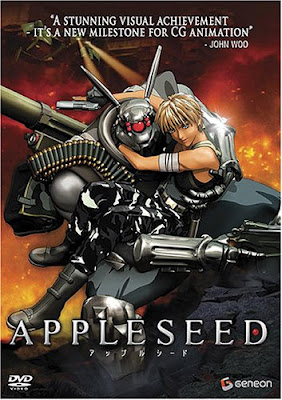March 19, 2006
Appleseed
Appleseed is one of those manga adaptations in which a thousand pages of backstory is squashed into 100 minutes of movie, the result being a tangle of story lines so confusing that you quickly give up and just enjoy the light show. Even the director says in the commentary track about some scenes, "I don't think anybody understood this part."
I've noticed that this backstory problem comes in two general varieties. The first is when the screenwriter starts with too much material and can't bear to part with it (as in this case). The second is when there was no backstory to begin with, and so the producers feel it necessary to make something up after the fact, and usually that something (Star Wars, The Matrix) is pretty awful.
There also needs to be moratorium on any more movies about supercomputers running the world. The rule is, if it ever turned up in an original Star Trek episode, then you've got to wait at least another century before using it again.
What Neal Stephenson says about Star Wars applies here as well: "[V]ery little of the new film makes sense, taken as a freestanding narrative. What's interesting about this is how little it matters. Millions of people are happily spending their money to watch a movie they don't understand."
Stephenson explains it as "geeking out," or immersing oneself in the details rather than the plot, story, or characters. The geek-out element in Appleseed that caught my attention is the digital animation. (Of course, the immediate audience for Appleseed would be those geeks who had already been following the Appleseed manga/anime series since its inception.)
It's all digital (as opposed to Innocence, in which the human beings are hand-drawn, a look I quite like). The static and mechanical elements are as good as you'll find elsewhere. It's the human characters that cost you the big bucks. Innocence and Appleseed offer two ways of getting around the huge rendering costs of trying to make digital people look real.
The problem--call it the Final Fantasy problem--is that really good digital animation of human beings still isn't good enough, and ends up making people look kinda creepy. The Pixar approach is to stay away from humans, or to keep them cartoony. Appleseed takes that retrogression a step further. It makes them look like anime characters again.
Hair, for example, is a bear to render digitally, so they don't even try. Hair is stylized the same chunky way it is in hand-drawn anime. Shading as well uses a very limited palette, just like in anime. The result are low-res digital characters that seem caught in a flatland between two and three dimensions, appearing hand-drawn sometimes and like sophisticated marionettes at others.
What's interesting is that the hand-drawn characters in Innocence, surrounded by digital animation, never jar the senses in the same way. I think it's about physical movement. The eye recognizes the human movements from the motion-capture, but then tries to append it to something that doesn't "look human." I found it both very weird and very compelling.
I've noticed that this backstory problem comes in two general varieties. The first is when the screenwriter starts with too much material and can't bear to part with it (as in this case). The second is when there was no backstory to begin with, and so the producers feel it necessary to make something up after the fact, and usually that something (Star Wars, The Matrix) is pretty awful.
There also needs to be moratorium on any more movies about supercomputers running the world. The rule is, if it ever turned up in an original Star Trek episode, then you've got to wait at least another century before using it again.
What Neal Stephenson says about Star Wars applies here as well: "[V]ery little of the new film makes sense, taken as a freestanding narrative. What's interesting about this is how little it matters. Millions of people are happily spending their money to watch a movie they don't understand."
Stephenson explains it as "geeking out," or immersing oneself in the details rather than the plot, story, or characters. The geek-out element in Appleseed that caught my attention is the digital animation. (Of course, the immediate audience for Appleseed would be those geeks who had already been following the Appleseed manga/anime series since its inception.)
It's all digital (as opposed to Innocence, in which the human beings are hand-drawn, a look I quite like). The static and mechanical elements are as good as you'll find elsewhere. It's the human characters that cost you the big bucks. Innocence and Appleseed offer two ways of getting around the huge rendering costs of trying to make digital people look real.
The problem--call it the Final Fantasy problem--is that really good digital animation of human beings still isn't good enough, and ends up making people look kinda creepy. The Pixar approach is to stay away from humans, or to keep them cartoony. Appleseed takes that retrogression a step further. It makes them look like anime characters again.
Hair, for example, is a bear to render digitally, so they don't even try. Hair is stylized the same chunky way it is in hand-drawn anime. Shading as well uses a very limited palette, just like in anime. The result are low-res digital characters that seem caught in a flatland between two and three dimensions, appearing hand-drawn sometimes and like sophisticated marionettes at others.
What's interesting is that the hand-drawn characters in Innocence, surrounded by digital animation, never jar the senses in the same way. I think it's about physical movement. The eye recognizes the human movements from the motion-capture, but then tries to append it to something that doesn't "look human." I found it both very weird and very compelling.
Related posts
Appleseed: Ex Machina
The "uncanny valley"
Labels: anime reviews, shirow, uncanny valley
Comments

